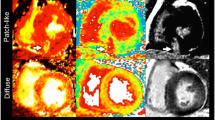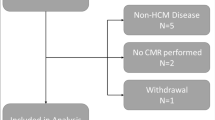Abstract
To identify myocardial fibrosis in hypertrophic cardiomyopathy (HCM) subjects using quantitative cardiac diffusion-weighted imaging (DWI) and to compare its performance with native T1 mapping and extracellular volume (ECV). Thirty-eight HCM subjects (mean age, 53 ± 9 years) and 14 normal controls (mean age, 51 ± 8 years) underwent cardiac magnetic resonance imaging (CMRI) on a 3.0T magnetic resonance (MR) machine with DWI, T1 mapping and late gadolinium enhancement (LGE) imaging as the reference standard. The mean apparent diffusion coefficient (ADC), native T1 value and ECV were determined for each subject. Overall, the HCM subjects exhibited an increased native T1 value (1241.04 ± 78.50 ms), ECV (0.31 ± 0.03) and ADC (2.36 ± 0.34 s/mm2) compared with the normal controls (1114.60 ± 37.99 ms, 0.24 ± 0.04, and 1.62 ± 0.38 s/mm2, respectively) (p < 0.05). DWI differentiated healthy and fibrotic myocardia with an area under the curve (AUC) of 0.93, while the AUCs of the native T1 values (0.93), (p > 0.05) and ECV (0.94), (p > 0.05) exhibited an equal differentiation ability. Both HCM LGE+ and HCM LGE− subjects had an increased native T1 value, ECV and ADC compared to the normal controls (p < 0.05). HCM LGE+ subjects exhibited an increased ECV (0.31 ± 0.04) and ADC (2.43 ± 0.36 s/mm2) compared to HCM LGE− subjects (p < 0.05). HCM LGE+ and HCM LGE− subjects had similar native T1 values (1250 ± 76.36 ms vs. 1213.98 ± 92.30 ms, respectively) (p > 0.05). ADC values were linearly associated with increased ECV (R2 = 0.36) and native T1 values (R2 = 0.40) among all subjects. DWI is a feasible alternative to native T1 mapping and ECV for the identification of myocardial fibrosis in patients with HCM. DWI and ECV can quantitatively characterize the extent of fibrosis in HCM LGE+ and HCM LGE− patients.







Similar content being viewed by others
References
Maron BJ (2002) Hypertrophic cardiomyopathy: a systematic review. J Am Med Assoc 287:1308–1320
St John Sutton MG, Lie JT, Anderson KR, O’Brien PC, Frye RL (1980) Histopathological specificity of hypertrophic obstructive cardiomyopathy. Myocardial fibre disarray and myocardial fibrosis. Br Heart J 44:433–443
Nigri M, Azevedo CF, Rochitte CE, Schraibman V, Tarasoutchi F, Pommerantzeff PM, Brandão CM, Sampaio RO, Parga JR, Avila LF, Spina GS, Grinberg M (2009) Contrast-enhanced magnetic resonance imaging identifies focal regions of intramyocardial fibrosis in patients with severe aortic valve disease: correlation with quantitative histopathology. Am Heart J 157(2):361–368
Rubinshtein R, Glockner JF, Ommen SR, Araoz PA, Ackerman MJ, Sorajja P, Bos JM, Tajik AJ, Valeti US, Nishimura RA, Gersh BJ (2010) Characteristics and clinical significance of late gadolinium enhancement by contrast-enhanced magnetic resonance imaging in patients with hypertrophic cardiomyopathy. Circ Heart Fail 3(1):51–58
Kuruvilla S, Adenaw N, Katwal AB, Lipinski MJ, Kramer CM, Salerno M (2014) Late gadolinium enhancement on cardiac magnetic resonance predicts adverse cardiovascular outcomes in nonischemic cardiomyopathy: a systematic review and meta-analysis. Circ Cardiovasc Imaging 7(2):250–258
Bruder O, Schneider S, Nothnagel D, Dill T, Hombach V, Schulz-Menger J, Nagel E, Lombardi M, van Rossum AC, Wagner A, Schwitter J, Senges J, Sabin GV, Sechtem U, Mahrholdt H (2009) EuroCMR (European Cardiovascular Magnetic Resonance) registry: results of the German pilot phase. J Am Coll Cardiol 54(15):1457–1466
Rehwald WG, Fieno DS, Chen EL, Kim RJ, Judd RM (2002) Myocardial magnetic resonance imaging contrast agent concentrations after reversible and irreversible ischemic injury. Circulation 105:224–229
Iles L, Pfluger H, Phrommintikul A, Cherayath J, Aksit P, Gupta SN, Kaye DM, Taylor AJ (2008) Evaluation of diffuse myocardial fibrosis in heart failure with cardiac magnetic resonance contrast-enhanced T1 mapping. J Am Coll Cardiol 52(19):1574–1580
Flett AS, Hayward MP, Ashworth MT, Hansen MS, Taylor AM, Elliott PM, McGregor C, Moon JC (2010) Equilibrium contrast cardiovascular magnetic resonance for the measurement of diffuse myocardial fibrosis: preliminary validation in humans. Circulation 122(2):138–144
Kali A, Choi EY, Sharif B, Kim YJ, Bi X, Spottiswoode B, Cokic I, Yang HJ, Tighiouart M, Conte AH, Li D, Berman DS, Choi BW, Chang HJ, Dharmakumar R (2015) Native T1 mapping by 3-T CMR imaging for characterization of chronic myocardial infarctions. J Am Coll Cardiol Cardiovasc Imaging 8(9):1019–1030
Wu Y, Zhang LJ, Zou C, Tse HF, Wu EX (2011) Transmural heterogeneity of left ventricular myocardium remodeling in postinfarct porcine model revealed by MR diffusion tensor imaging. J Magn Reson Imaging 34(1):43–49
Nguyen C, Fan Z, Xie Y, Dawkins J, Tseliou E, Bi X, Sharif B, Dharmakumar R, Marbán E, Li D (2014) In vivo contrast free chronic myocardial infarction characterization using diffusion-weighted cardiovascular magnetic resonance. J Cardiovasc Magn Reson 16:68
van Oorschot JW, El Aidi H, Jansen of Lorkeers SJ, Gho JM, Froeling M, Visser F, Chamuleau SA, Doevendans PA, Luijten PR, Leiner T, Zwanenburg JJ (2014) Endogenous assessment of chronic myocardial infarction with T(1ρ)-mapping in patients. J Cardiovasc Magn Reson 16:104. doi:10.1186/s12968-014-0104-y
Wu MT, Su MY, Huang YL, Chiou KR, Yang P, Pan HB, Reese TG, Wedeen VJ, Tseng WY (2009) Sequential changes of myocardial microstructure in patients postmyocardial infarction by diffusion-tensor cardiac MR: correlation with left ventricular structure and function. Circ Cardiovasc Imaging 2(1):32–40
Bottomley PA, Weiss RG (2001) Noninvasive localized MR quantification of creatine kinase metabolites in normal and infarcted canine myocardium. Radiology 219(2):411–418
Rogers T, Dabir D, Mahmoud I, Voigt T, Schaeffter T, Nagel E, Puntmann VO (2013) Standardization of T1 measurements with MOLLI in differentiation between health and disease—the ConSept study. J Cardiovasc Magn Reson 15:78. doi:10.1186/1532-429X-15-78
Pop M, Ghugre NR, Ramanan V, Morikawa L, Stanisz G, Dick AJ, Wright GA (2013) Quantification of fibrosis in infarcted swine hearts by ex vivo late gadolinium-enhancement and diffusion-weighted MRI methods. Phys Med Biol 58(15):5009–5028
Abdullah OM, Drakos SG, Diakos NA, Wever-Pinzon O, Kfoury AG, Stehlik J, Selzman CH, Reid BB, Brunisholz K, Verma DR, Myrick C, Sachse FB, Li DY, Hsu EW (2014) Characterization of diffuse fibrosis in the failing human heart via diffusion tensor imaging and quantitative histological validation. Nucl Magn Reson Biomed 27(11):1378–1386
Tseng W-YI, Dou J, Reese TG, Wedeen VJ (2005) Imaging myocardial fiber disarray and intramural strain hypokinesis in hypertrophic cardiomyopathy with MRI. J Magn Reson Imaging 23:1–8
Urbano-Moral JA, Rowin EJ, Maron MS, Crean A, Pandian NG (2014) Investigation of global and regional myocardial mechanics with 3-dimensional speckle tracking echocardiography and relations to hypertrophy and fibrosis in hypertrophic cardiomyopathy. Circ Cardiovasc Imaging 7(1):11–19
Nguyen C, Lu M, Fan Z, Bi X, Kellman P, Zhao S, Li D (2015) Contrast-free detection of myocardial fibrosis in hypertrophic cardiomyopathy patients with diffusion-weighted cardiovascular magnetic resonance. J Cardiovasc Magn Reson 17(1):107
Klues HG, Schiffers A, Maron BJ (1995) Phenotypic spectrum and patterns of left ventricular hypertrophy in hypertrophic cardiomyopathy: morphologic observations and significance as assessed by two-dimensional echocardiography in 600 patients. J Am Coll Cardiol 26:1699–1708
Schulz-Menger J, Bluemke DA, Bremerich J, Flamm SD, Fogel MA, Friedrich MG, Kim RJ, von Knobelsdorff-Brenkenhoff F, Kramer CM, Pennell DJ, Plein S, Nagel E. (2013) Standardized image interpretation and post processing in cardiovascular magnetic resonance: society for cardiovascular magnetic resonance (SCMR) board of trustees task force on standardized post processing. J Cardiovasc Magn Reson 15:35. doi:10.1186/1532-429X-15-35
McGill LA, Ismail TF, Nielles-Vallespin S, Ferreira P, Scott AD, Roughton M, Kilner PJ, Ho SY, McCarthy KP, Gatehouse PD, de Silva R, Speier P, Feiweier T, Mekkaoui C, Sosnovik DE, Prasad SK, Firmin DN, Pennell DJ (2012) Reproducibility of in-vivo diffusion tensor cardiovascular magnetic resonance in hypertrophic cardiomyopathy. J Cardiovasc Magn Reson 14:86. doi:10.1186/1532-429X-14-86
Laissy J, Gaxotte V, Pasi N (2011) Cardiac diffusion-weighted MR imaging in recent, subacute and chronic myocardial infarction: a pilot study. J Magn Reson Imaging 13(Suppl 1):O46
Deux J-F, Maatouk M, Vignaud A (2011) Diffusion-weighted echo planar imaging in patients with recent myocardial infarction. Eur Radiol 21(1):46–53
Nensa F, Mahabadi AA, Erbel R (2013) Myocardial edema during acute myocardial infarction visualized by diffusion-weighted MRI. Herz 38(5):509–510
Okayama S, Uemura S, Saito Y (2009) Detection of infarct-related myocardial edema using cardiac diffusion-weighted magnetic resonance imaging. Int J Cardiol 133:e20–e21
Mekkaoui C, Reese TG, Jackowski MP, Bhat H, Sosnovik DE (2015) Diffusion MRI in the heart. Nucl Magn Reson Biomed. doi:10.1002/nbm.3426
Rapacchi S, Wen H, Viallon M, Grenier D, Kellman P, Croisille P, Pai VM (2011) Low b-value diffusion-weighted cardiac magnetic resonance imaging: initial results in humans using an optimal time-window imaging approach. Invest Radiol 46(12):751–758
Potet J, Rahmouni A, Mayer J, Vignaud A, Lim P, Luciani A, Dubois-Randé JL, Kobeiter H, Deux JF (2013) Detection of myocardial edema with low-b-value diffusion-weighted echo-planar imaging sequence in patients with acute myocarditis. Radiology 269(2):362–369
Funding
This study was funded by National Natural Science Foundation of China (Youth Program No. 81401403).
Author information
Authors and Affiliations
Corresponding author
Ethics declarations
Conflict of interest
Authors declare that they have no conflict of interest.
Ethical approval
All procedures performed in this study that involved human participants were in accordance with the ethical standards of the institutional research committee and with the 1964 Helsinki Declaration and its later amendments or comparable ethical standards.
Informed consent
Informed consent was obtained from all individual participants included in the study.
Rights and permissions
About this article
Cite this article
Wu, LM., Chen, BH., Yao, QY. et al. Quantitative diffusion-weighted magnetic resonance imaging in the assessment of myocardial fibrosis in hypertrophic cardiomyopathy compared with T1 mapping. Int J Cardiovasc Imaging 32, 1289–1297 (2016). https://doi.org/10.1007/s10554-016-0909-x
Received:
Accepted:
Published:
Issue Date:
DOI: https://doi.org/10.1007/s10554-016-0909-x




